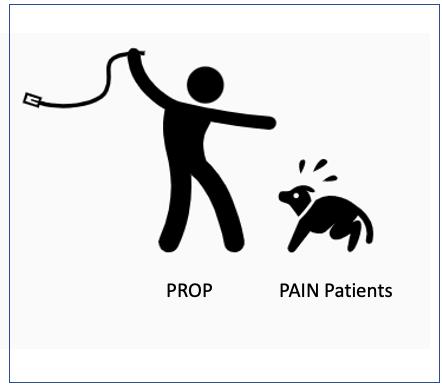Although it took four years, the American Medical Association's 2020 letter to Dr. Deborah Dowell, the Chief Medical Officer of the National Center for Injury Prevention and Control at the CDC was a welcome and necessary first step in mitigating the awful damage done by the Guideline for Prescribing Opioids for Chronic Pain, which was published by CDC in 2016.
Predictably, the Physicians for Responsible Opioid Prescribing (PROP), which rarely misses a chance to promote its indefensible anti-opioid agenda, responded with a letter to the AMA that was published earlier this year in BMJ. The letter contains the same trickery, clever wordsmanship, and cherry-picking of data that has characterized virtually all communications from PROP dating back to the time the group was formed.
Following are selected passages from this letter followed by my comments.
"On behalf of Physicians for Responsible Opioid Prescribing (PROP), we are writing to share our concern about the AMA’s recent public statements on opioid prescribing."
On behalf of the people who have suffered the effects of PROP's devastating war on patients, I welcome any input from the AMA. Or any other group that is willing to stand up to self-appointed opioid czars.
"It is disappointing that the AMA chose to fight key elements of the CDC’s effort to address the scourge of overprescribing of opioids in its letter to Dr. Deborah Dowell."
Agreed. It is disappointing that it didn't happen sooner.
"[T]he AMA concurrently repudiates the CDC’s pain treatment recommendations on opioid dose and duration, guidance ..."
And well it should. For several reasons:
- Exactly who asked PROP for advice?
- Is PROP qualified to give advice?
- Please explain how PROP, an NGO with no official capacity, became intimately involved in the CDC's misguided effort to regulate opioid drugs.
- Are there any undisclosed conflicts of interest that have played a part in PROP's involvement?
- Please explain why the CDC is involved in any aspect of the regulation of drugs or what gives the agency either the authority or expertise to do so.
- The "guidance" itself is medically unsound because it is based on faulty science in that it fails to take even the most fundamental principles of pharmacology into account. It should be soundly repudiated.
"[I]ndustry friendly messaging on opioid use for pain can be found buried amid the effort to repair the problems created in the first place, and in no insignificant part, by erroneous messaging."
Resorting to blaming industry is the hallmark of a weak argument.
"Particularly concerning are erroneous statements such as “the nation no longer has a prescription opioid-driven epidemic”
It may be concerning to PROP but that does not make it true. A three-year 2019 Massachusetts study concluded that a prescription opioid was found in only 16.5% of people who died from an opioid overdose (the rest being heroin and illicit fentanyl and its analogs) and that only 1.3% of overdose deaths arose from the drug that matched the prescription given to the patient. How is this consistent with a prescription drug-driven epidemic?
Furthermore, Dr. Jeffrey Singer of the Cato Institute and also a member of the ACSH Scientific Advisory Board makes this clear in his May 24th article:
"[D]ata provided by the CDC and the National Survey on Drug Use and Health consistently show no association between the number of prescriptions dispensed and the rate of non-medical use of prescription opioids or of opioid use disorder. In other words, opioid deaths are primarily driven by non-medical usage.
Jeffrey Singer, M.D.
"There is compelling evidence that many of those currently struggling with opioid dependence and addiction were introduced to opioids through use of medically prescribed opioids used to treat chronic pain."
A review article by Nora D. Volkow, M.D., the Director of the National Institute on Drug Abuse, and A. Thomas McLellan, Ph.D. writing in The New England Journal of Medicine in 2016 paints a different picture:
“Unlike tolerance and physical dependence, addiction is not a predictable result of opioid prescribing… Addiction occurs in only a small percentage of persons who are exposed to opioids — even among those with pre-existing vulnerabilities."
"While it has been reported that some of the CDC’s recommendations were misapplied as strict limits, this does not lessen the need for evidence-based opioid prescribing guidance on dose and duration."
- The recommendations were, for the most part, applied, not misapplied as strict limits. How else can PROP account for different legal restrictions of opioid dosage, number of pills, or both, in 36 states?
- Did PROP play a part in influencing state legislatures? If so, why?
- If PROP were so concerned about the "misapplication" of their "advice" why have we not heard one word from the group about this misapplication over the past five years?
"Suggested dose and duration only become “arbitrary” when applied too rigidly, or if they are used as license to abruptly cut prescribing to individuals that have become dependent on opioids for stability."
This is mind-boggling. PROP's "suggestions" and subsequent CDC "advice" has led to a widespread and involuntary tapering of opioid doses regardless of whether the pain patients had been functioning well for years, if not decades, on high-dose opioid therapy. Involuntary tapering sounds more like a practice that might be used in a concentration camp than medical policy in the United States.
"By all means apply moral arguments and principles to make sure opioids are available for the right indications, but it makes no sense at all to suggest that removing guidance on opioid dose and duration is needed so that people with chronic pain do not suffer."
This statement is especially egregious. First, who other than doctors should make the determination of "the right indications?" Second, PROP has made sure that opioids are not available for the right indications and frequently any indications. Perhaps PROP should share with us the statistics concerning the number of physicians who have left the field of pain management and how this alone has contributed mightily to patient suffering.
"[I]t makes no sense at all to suggest that removing guidance on opioid dose and duration is needed so that people with chronic pain do not suffer.
Yes, it does, when that guidance is causing people with chronic pain to suffer.
"Physicians were relieved to have the standards provided by the CDC guidelines.
"How many? Two? Two hundred? Has PROP polled a large group of physicians and collected data to support this contention?
Does this also include the physicians who have been persecuted by a runaway DEA and state medical boards because they may have prescribed more than the PROP "recommendations?"
And PROP is presumptuous to think that it represents other physicians who also want responsible opioid use. The American Medical Association represents far more physicians –in many more specialties – and they also want responsible opioid use; as does the American Society of Addiction Medicine (ASAM), the premier addiction medicine certification and accreditation organization, who criticized and protested the CDC's morphine milligram equivalent recommendations. What makes members of PROP think they are the only doctors who want responsible opioid use, let alone are an authority on it?
"Removing these evidence-based norms for opioid prescribing will not help either physicians or patients."
I challenge PROP to demonstrate that a maximum daily dose of 90 Morphine Milligram Equivalents is based on any evidence whatsoever. Where did this number come from? Does it take into account rapid opioid metabolizers? Slow opioid metabolizers? Is metabolism or personal history of individual patients even considered when establishing a maximum dose? Why should government, let alone an NGO, even establish such a number, especially since it is the antithesis of personalized medicine.
Fortunately, the FDA is now conducting a workshop to examine "Morphine Milligram Equivalents: Current Applications and Knowledge Gaps, Research Opportunities, and Future Directions." Although long overdue, perhaps it can be taken as a sign that the FDA will no longer roll over and play dead when it comes to the institution (and science) of drug policy.
But the damage done by this rogue group will not be easily undone.




